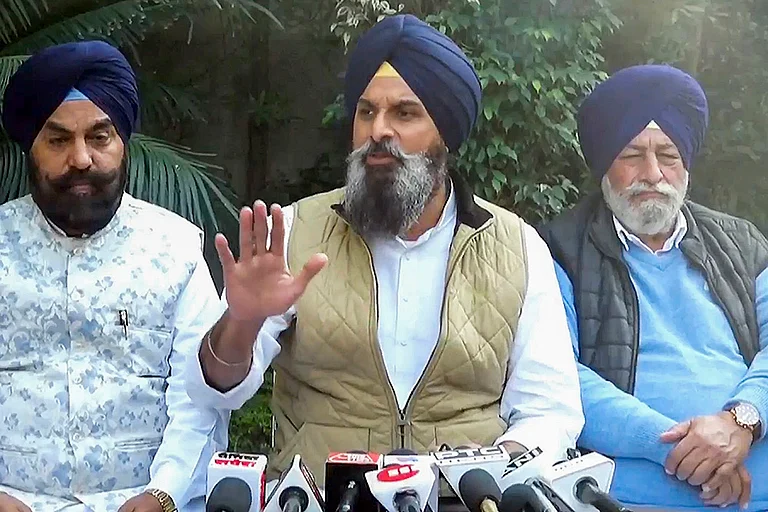“Such the confusion now between the real—how say the contrary? No matter. That old tandem. Such now the confusion between them once so twain.”
—Samuel Beckett
I don’t want to watch The Kashmir Files. Despite prime ministerial appreciation. Despite the home minister’s admiration. Despite cathartic relief expressed by many Kashmiri Pandits. Despite it being hailed in and by the media and taking over social media by storm. Despite state governments granting tax exemptions, half-day leave for employees to watch it, and seeking a GST waiver. Despite its tickets being offered to legislators to get educated about Kashmir. Despite mobs forcibly stopping screening of other films only to be able to watch the film. When was the last time when the screening or watching of a film—a commercial one at that—was promoted as national duty? Soon enough, those who will not watch it will be labelled anti-national.
More people have sought my views on this film than on any other matter relating to Kashmir—be it holiday recommendations or the reading down of Article 370. Yet, I don’t want to watch it. Not because it is a political film—at some level, all films are. Or a propaganda film as it has been labelled. Or because it is ideologically predisposed, hence partisan. Even if it is all of these, The Kashmir Files is neither the first of its kind, nor will it be the last.
ALSO READ: Kashmir: This Isn’t A Postcard Series
At best, it is a commercial film made by not a particularly well-regarded filmmaker, who incidentally has hit the jackpot with this. At worst, it is a product of the times we live in. In which case, the film per se is not the real problem, the public response to it is. The former, even though inspired by historical events, is fiction. The latter is a reality. To merge the two and construct such an impactful narrative requires more than just cinematographic skills.
It is obvious that the need to re-narrate the exodus of Pandits arises from the events of August 5, 2019, and heralds the re-imagining of Kashmir by Bollywood. For Kashmir, the Constitutional amendments changed what Perry Anderson called “seriality”—the social construct that underlies political existence. The unprecedented success of The Kashmir Files lies in giving vent to the subconscious authority of the nation on Kashmir, including the discourse on it, subsequent to the constitutional developments. As such, watching it is endorsing the mass hysteria generated by an audience which is willing, indeed waiting, to supplement and amplify the control to beyond the confines of the government and into the arena of civil society. What better medium than popular cinema to do that?

For me, watching this film is furthering the narrative—not in terms of being true or false in what is shown—but in what it reveals. This is so because I don’t have the luxury and liberty of watching it as a neutral audience, and duly fulfilling “national duty” by expressing outrage and seeking retribution. Unlike most people who have seen the film, all Kashmiris—individually and collectively—in their own traumatic ways, have lived through the horrors of the last three decades.
ALSO READ: Routes Of Grief: Two Translations
Do I watch the film as the perpetrator of the genocide that this film—consciously and unambiguously—makes me out to be? Or perhaps as a participant in the pogrom? Or me as the victim of history? Or an unintentional collaborator in a conspiracy? Or me as a Kashmiri with a lifetime of deep and enduring emotional bonds with the persecuted protagonists in the film? Or me as a jihadist? I am not sure. Not anymore.
Even if it has been “manufactured”, so overwhelming is the response to, and acceptance of the film, that a cinematic representation has now replaced the historical reality of the Pandit exodus. Well-respected editors seek to cut the clutter, hoping to educate two generations of India about the tragedy in Kashmir through a commercial film. Such is the power of this fiction that engages with facts asymptotically—that even J&K Police has expressed its readiness to reopen three-decade-old cases (Kashmir files, anyone?)—though no new facts or evidence has come into the public domain through the film. Nor does the film claim to do so.

ALSO READ: Kashmir: Of ‘Stories’ And Friends
The pain, the persecution and the politics of the Pandit exodus, which the film deals with, has been recorded over the last 32 years many times over. Be it in newspapers by those who reported it, or successive governments—both at the Centre and the state—who failed to act but acted only to count the dead by rote. Books by people in control during that period, like Jagmohan Malhotra’s My Frozen Turbulence in Kashmir or commentators like Manoj Joshi, who has described it in great detail in his book The Lost Rebellion. Not to speak of Pandit activists and organisations who have painfully and painstakingly documented it.
Of late, a younger generation of writers like Rahul Pandita and Siddartha Gigoo, who at the time of the exodus were old enough to be scarred for life, but young enough to rebuild their lives, have sought to memorialise the trauma of their community which goes beyond counting of the killed. Political parties, right across the ideological spectrum, have propagated it, albeit for their own good, rather than for the greater good of the Pandit community.

ALSO READ: The ‘Homeland’ Dream Of Kashmiri Pandits
As such, The Kashmir Files should not be dismissed with disdain as a propaganda film. It is perhaps better described as a Pandit narrative of victimhood which draws its strength from the tragic events of March 1990. Individual success stories and glories apart, Pandits as a community are in an existential crisis. Indeed, their distinctive cultural and religious identity has been under threat since.
ALSO READ: Kashmir Files: Memories Of Another Day
In the fictionalised storyline, hysterics may have dumbed down aesthetics, but it is with a purpose: to take a victim stance, which is a powerful one. It is always morally right, neither responsible nor accountable, and entitled to sympathy. The film has succeeded in it because of unequivocal endorsement by the people who have suffered the exodus. The political appropriation only came afterwards.
The marketing strategy of doing a series of private screenings with groups of Pandits, filming their spontaneous cathartic reactions and putting these out in social media, set the tone for reception of the film. It stamped the film with authenticity and legitimacy that no amount of data, research or fact-finding could have ever done. When people who had suffered the exodus endorsed it, it effectively converted a commercial cinematic representation into a fact-based documentary. With that, The Kashmir Files ceased to be a Vivek Agnihotri film. It became every Kashmiri Pandit’s life story. History has not been re-enacted but rewritten. If not in text books just yet, but certainly in the collective memory of India.

This in itself serves a big purpose for the Pandits; they feel they have finally been heard and recognised. Especially by those—the civil society of the country—on whom they had reposed so much faith in all these years. They are seeing the film as a transformative experience for an overwhelming majority of the people all over the country and in the diaspora. The articulation of the three-decade-old tragedy through the film has been a means to acknowledge their suffering and grant them a sense of recognition and empowerment. No one should grudge that.
It is the way in which this recognition is framed in the film that is problematic: presenting the position of victims as sharply distinct from and opposed to those of their victimisers, who are portrayed as an undifferentiated lot. The meta-narrative of the Indian society, delineation of “displaced Kashmiris” (Pandits) as victims with the “misplaced Kashmiris” (Muslims) as perpetrators, is at variance not only with the history of the Valley, but also with its contemporary reality.
ALSO READ: Loss And Longing In Kashmir
Just like the Pandits, the Muslims too have narratives of victimhood that they also use to achieve certain purposes. Unlike the Pandits, the Muslims don’t have one common narrative of victimhood; there are many. Most are based on account of daily hardships, tragedy and hopelessness, as well loss of rights and respect.
Yet, in the last 32 years, I am yet to meet a Kashmiri Muslim who has, even privately, let alone publicly, justified or endorsed the exodus. For that matter, not even any Kashmiri separatist of any standing has ever tried to justify or capitalise on it. No one knows it better than them that it damaged their cause more than anything else. Hence, like everything else, they blamed it on their “Other”, which is the Government of India. An overwhelming majority of Kashmiri Muslims did believe the exodus was planned and executed by Jagmohan Malhotra to discredit the spread and sentiment of a fledgling but fast-growing separatist movement. It is important to understand that this narrative, where all egregious acts are always attributable to the Government of India and “agencies”, seeks to deflect, indeed eschew, personal responsibility—against violence in general and Pandits in particular.
ALSO READ: Kashmir: The Political Capital Of Pain
The ironic uniqueness of the situation lies in the fact that Kashmiris—Pandits and Muslims—are now defining themselves in relation to their respective narratives of victimhood. These are being made central to the development of identity in the aftermath of victimisation experiences. In the process, the historically inherited, socially intertwined and cultural interwoven ethnicity is being subsumed, indeed consciously negated. This reflects the existential crisis that Kashmir and Kashmiris have been in.
(This appeared in the print edition as "Requiem for a Dream")
(Views expressed are personal)
ALSO READ
Haseeb A Drabu is an economist from Kashmir who has been a banker, legislator, finance minister of J&K and national level policy planner





















